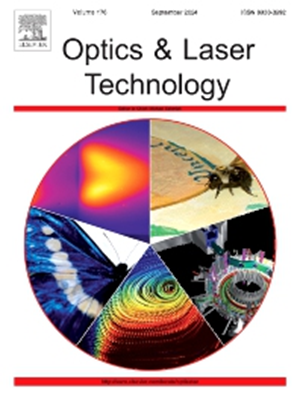Graded-Index 4-LP-Mode fiber with ultralow differential mode group delay
IF 4.6
2区 物理与天体物理
Q1 OPTICS
引用次数: 0
Abstract
The few-mode fiber (FMF) plays a crucial role in mode division multiplexing systems. However, FMFs suffer from intermodal dispersion, which increases the bit error rate and the complexity of digital signal processing. In this letter, we report a trench-assisted graded-index fiber that supports four linearly polarized (LP) modes with a low differential mode group delay (DMGD). We propose a novel design-for-manufacturing strategy by integrating fabrication tolerance metrics into a genetic algorithm (GA) for simultaneous multi-parameter optimization. This co-optimization approach minimizes both DMGD and its sensitivity to structural perturbations, addressing a critical bottleneck in practical FMF deployment. A maximum DMGD of 15 ps/km is experimentally verified, which achieves the lowest record among all reported FMFs supporting more than 4 modes, representing a 50 % reduction compared to prior art. Moreover, 40 Gbps quadrature phase shift keying (QPSK) signals are transmitted through a 20 km FMF with low DMGD, achieving error-free reception without the need of dispersion compensation. The synergy of ultralow DMGD, large effective mode area, and high fabrication tolerance shows promise for simplifying MIMO in long-haul MDM and enabling high-capacity short-reach systems.
具有超低差模群延迟的梯度折射率4- lp模光纤
在模分复用系统中,少模光纤(FMF)起着至关重要的作用。然而,FMFs存在模间色散,这增加了误码率和数字信号处理的复杂性。在这封信中,我们报告了一种沟槽辅助梯度折射率光纤,它支持四种线性偏振(LP)模式,具有低差分模群延迟(DMGD)。本文提出了一种新的面向制造的设计策略,该策略将制造公差度量集成到遗传算法(GA)中,用于同时进行多参数优化。这种协同优化方法最大限度地减少了DMGD及其对结构扰动的敏感性,解决了实际FMF部署中的一个关键瓶颈。实验验证了最大DMGD为15 ps/km,这是所有支持4种以上模式的fmf中最低的记录,与现有技术相比降低了50%。此外,40 Gbps正交相移键控(QPSK)信号通过低DMGD的20 km FMF传输,无需色散补偿即可实现无差错接收。超低DMGD、大有效模式面积和高制造公差的协同作用,有望简化长距离MDM中的MIMO,并实现高容量短距离系统。
本文章由计算机程序翻译,如有差异,请以英文原文为准。
求助全文
约1分钟内获得全文
求助全文
来源期刊
CiteScore
8.50
自引率
10.00%
发文量
1060
审稿时长
3.4 months
期刊介绍:
Optics & Laser Technology aims to provide a vehicle for the publication of a broad range of high quality research and review papers in those fields of scientific and engineering research appertaining to the development and application of the technology of optics and lasers. Papers describing original work in these areas are submitted to rigorous refereeing prior to acceptance for publication.
The scope of Optics & Laser Technology encompasses, but is not restricted to, the following areas:
•development in all types of lasers
•developments in optoelectronic devices and photonics
•developments in new photonics and optical concepts
•developments in conventional optics, optical instruments and components
•techniques of optical metrology, including interferometry and optical fibre sensors
•LIDAR and other non-contact optical measurement techniques, including optical methods in heat and fluid flow
•applications of lasers to materials processing, optical NDT display (including holography) and optical communication
•research and development in the field of laser safety including studies of hazards resulting from the applications of lasers (laser safety, hazards of laser fume)
•developments in optical computing and optical information processing
•developments in new optical materials
•developments in new optical characterization methods and techniques
•developments in quantum optics
•developments in light assisted micro and nanofabrication methods and techniques
•developments in nanophotonics and biophotonics
•developments in imaging processing and systems

 求助内容:
求助内容: 应助结果提醒方式:
应助结果提醒方式:


